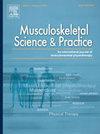Comparing the efficacy of two E-learning programs on physiotherapists' knowledge, attitudes, and confidence in musculoskeletal pain management: A randomized trial
IF 2.2
3区 医学
Q1 REHABILITATION
引用次数: 0
Abstract
Background
Physiotherapists play a crucial role in managing patients with musculoskeletal pain. However, their training often lacks focus on pain management.
Objectives
This randomized controlled trial evaluated the effects of two e-learning programs on physiotherapists’ knowledge, attitudes, and confidence in musculoskeletal pain management.
Methods
Eligible participants had active professional registration, treated patients with musculoskeletal pain, and had internet access. Participants were randomized into two groups (video-based and booklet-based), with interventions lasting 5 weeks. Assessments were conducted at baseline, 6 weeks (T1), and 12 weeks (T2) using the Neurophysiology of Pain Questionnaire, a pain attitude survey, and self-reported confidence.
Results
A total of 211 physiotherapists were randomized (video = 106; booklet = 105). Both groups improved pain neurophysiology knowledge, with the booklet group scoring higher at T1 (adjusted mean difference = 1.25, 95%CI = 0.93 to 1.58) and T2 (adjusted mean difference = 1.30, 95%CI = 0.97 to 1.63). Attitudes varied: the booklet group improved in emotion (adjusted mean difference = −0.19, 95%CI = −0.35 to −0.03) and control (adjusted mean difference = −0.20, 95%CI = −0.37 to −0.03) at T2, while the video group improved in solicitude (adjusted mean difference = −0.37, 95% CI: 0.55 to −0.19) and disability at T1 and T2. No significant effects were found in the medical cure domain, and no interaction effects were observed in the physical harm domain. Confidence increased in both groups, with no between-group differences.
Conclusion
Both e-learning programs effectively enhanced physiotherapists’ knowledge, attitudes, and confidence in musculoskeletal pain management, demonstrating the value of e-learning for continuing education.
求助全文
约1分钟内获得全文
求助全文
来源期刊

Musculoskeletal Science and Practice
Health Professions-Physical Therapy, Sports Therapy and Rehabilitation
CiteScore
4.10
自引率
8.70%
发文量
152
审稿时长
48 days
期刊介绍:
Musculoskeletal Science & Practice, international journal of musculoskeletal physiotherapy, is a peer-reviewed international journal (previously Manual Therapy), publishing high quality original research, review and Masterclass articles that contribute to improving the clinical understanding of appropriate care processes for musculoskeletal disorders. The journal publishes articles that influence or add to the body of evidence on diagnostic and therapeutic processes, patient centered care, guidelines for musculoskeletal therapeutics and theoretical models that support developments in assessment, diagnosis, clinical reasoning and interventions.
 求助内容:
求助内容: 应助结果提醒方式:
应助结果提醒方式:


